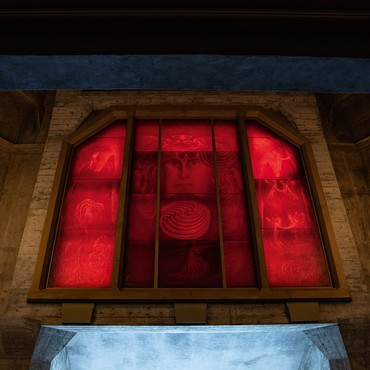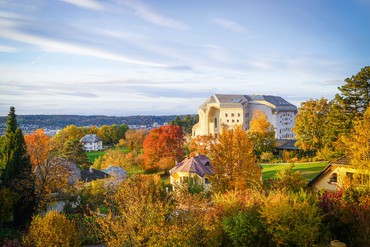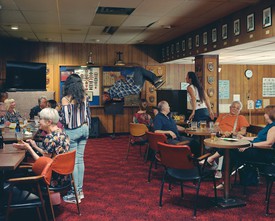
Ross Simonini is an interdisciplinary artist, writer, and musician. His work comprises paintings, drawings, essays, dialogues, musical compositions, performance, and fiction.
When I started believing in contemporary art, I found my imagination possessed by the work of Joseph Beuys. It was the kind of totalizing obsession that happened often in the highly receptive time of youth, sending me into a frenzy of new thoughts and compulsory artmaking. The most generative of these infatuations were the artists who served as portals into a knowledge beyond art, and Beuys proved especially useful in this way, pointing toward concepts and figures I had never before encountered, from Tatar shamanism to Celtic mythology to a remarkable man named Rudolf Steiner.
Like many Americans, I was unfamiliar with Steiner, though I was intimately familiar with the fruits of his work: I had eaten his food, rubbed his salves on my body, and known many friends to attend his schools. Steiner was a polymath and his work took many, many forms: agriculture, education, medicine, philosophy, mysticism, politics, architecture, dance, design, sculpture, and painting. He invented biodynamic farming, Waldorf schooling, the Camphill Movement (for children with developmental disabilities), Weleda naturopathic products (Skin Food, Salt Toothpaste, and my personal favorite deodorant), eurythmy (a kind of dance), and anthroposophy, the all-encompassing philosophy that serves as the foundation for all of Steiner’s work.
It’s an almost inhuman spectrum of accomplishment from a man who believed there was no boundary to human knowledge. But what’s especially surprising about Steiner’s work is how it continues to broadly affect culture now, a century after his death. The sheer magnitude of what he produced seems to allow an ongoing study of his thought: his collected works comprise 422 volumes, including his many books, essays, plays, lectures (6,000+), and 80 volumes on his artistic work, all completed by his early death, at the age of sixty-four.
Steiner’s influence in art has also been potent, though he is only rarely included in the canon of modern art. Beuys, for example, saw his own work as a way to transmit Steiner’s theory of “social threefolding,” which aims to balance the three spheres of society—political, economic, and cultural—and to avoid the dangerous systems that emerge when one sphere dominates, such as communism, capitalism, and religion. Beuys said, “I know that, from [Steiner], a mission was given to me to gradually remove people’s alienation and mistrust toward the supersensible through my means. In political thinking—the field I have to be working on daily—it is a matter of realizing the Threefold Social Order as quickly as possible.”1 Beuys’s blackboard drawings charting this theory are direct homages to Steiner’s very similar blackboard diagrams of cosmic, pastel fireworks.
Over the last century, many artists engaged with Steiner’s work. Some of the Bauhaus artists (Vasily Kandinsky, etc.) attended his lectures and closely studied his ideas, as did writers from Franz Kafka to Saul Bellow. The architect Marion Mahony Griffin (one of the world’s first licensed female architects), the famed conductor Bruno Walter, the novelist Selma Lagerlöf (the first woman to win the Nobel Prize), the Symbolist painter Hermann Linde, and the Swiss physician Hans Jenny were all official anthroposophists. This is a group of innovators.
Early in his career, Steiner was associated with theosophy, a religion principally founded by Madame Helena Blavatsky in New York in 1875. He lectured for almost a decade in theosophical centers and led the religion’s Esoteric Society for Germany and Austria. Theosophy is an indisputably essential part of modern art, directly inspiring such artists as Max Beckmann, František Kupka, Piet Mondrian, Kazimir Malevich, and Kandinsky—the last three of whom have been variously credited with the birth of abstract art. Kandinsky’s book Concerning the Spiritual in Art (1912) is basically a theosophical study of form, color, and composition. In an interview last fall on the podcast The Art Angle, the artist Carol Bove remarked, “The early twentieth century needed theosophy to become abstract, but when abstraction developed again after World War II, artists didn’t need it anymore.”2
The influence of theosophy on the early avant-garde is well documented but not always accepted, probably because of a general suspicion of esotericism across culture: religious believers may see it as heretical, atheist materialists see it as incongruous with science, and art historians usually favor the analytic precision of formalism over the murkiness of spirituality.
In recent years, however, the apotheosis of the Swedish painter and mystic Hilma af Klint as a prophet of abstraction (mostly due to the 2018–19 show at New York’s Guggenheim Museum) has compelled critics to reckon with the esotericism at the foundation of modernism. Af Klint studied theosophy but never joined the Theosophical Society, and when Steiner left the faith to create the anthroposophical movement, in 1912, she quickly became an anthroposophist. From then on she maintained a lifelong interest in Steiner’s work and several times asked him for advice on her paintings, which he gave.3 Indeed, a decade after Steiner’s death, in 1925, af Klint was still lecturing to the Anthroposophical Society about the harmony between her work and his ideas, and she often spent long retreats at the society’s headquarters in Switzerland, a singular biomorphic edifice known as the Goetheanum.
art . . . for many of us, is a practice of transforming matter into something more than the sum of its parts, something transcendent and essentially nonmaterial.
I recently traveled to Zurich for an exhibition of my paintings and drawings at suns.works, a show held in a former bank office at the top of a skyscraper downtown. While there I planned to visit the Goetheanum, about an hour away in the village of Dornach, which in turn is about twenty minutes from Basel and another twenty from some of the largest pharmaceutical companies in the world.
To arrive at this architectural wonder, designed by Steiner himself, my wife and I walked through the village, up a hill, and crossed a grand esplanade to the Goetheanum’s front doors, heavy and thick, with unexpected, asymmetrical handles. The building’s facade is gray and brutalist, but its curved, alien forms appear soft, almost viscous. Its architecture is often called expressionist and recalls Antoni Gaudí in its organic freedom. It has been praised by architects as disparate as Frank Lloyd Wright and Zaha Hadid and is described as foreshadowing the work of Buckminster Fuller.4 Like these designers, Steiner took his principles from the natural world, so there are almost no right angles in the Goetheanum. Steiner believed that hard lines imprison the mind, which is why so much anthroposophical art expresses the fluid energy of a wave.
Inside, a statue of a celestial-looking being greets visitors, its face oddly convex, as if its awareness were pointed totally inward. The building is open to the public daily, and when I was there, on a Wednesday afternoon, a few international travelers were wandering through the grounds. The Goetheanum World Conference was held a few days later and various rooms were being prepared for the event. This is in fact the second Goetheanum, and the new construction is in some way a reinvention of the original. The first, built a decade before this one, was mostly made of curved wooden boat panels and burned to the ground on New Year’s Eve, 1922. Anthroposophists claim that the fire was arson, set by enemy esotericists who resented Steiner’s revelations of secret occult knowledge to the world. To remedy this problem, the new Goetheanum was made from concrete.
I’d been told by a German friend that the staff didn’t have the most welcoming manner, and this immediately seemed true. The attendant at the front desk barely answered my questions and a grumpy barista in the café would not meet my eyes as he served me a whole-grain croissant, which, like most of the menu, had been biodynamically produced. There was a mystery here, and no one seemed interested in explaining, let alone proselytizing.
Yet even for a visitor with no knowledge of Steiner’s ideas, someone who accidentally stumbles upon the building, the Goetheanum is clearly the manifestation of a very fastidious philosophy. Every wall is painted in soothing sponge-painted pastels, and even the inconspicuous radiator in the corner is a pleasant matte periwinkle. Light fixtures, architraves, chairs, window frames, and doors are all molded with the same dimples and rivulets as the building’s exterior. The sculptor Edith Maryon, who lived and taught at the Goetheanum, helped to design the building, and you can feel this aesthetic intention in every subtle choice.
My wife, Kate, had an instant knee-jerk reaction against the place. The slightest whiff of cult repulses her, and the Goetheanum seems to wear its beliefs as proudly as any church, but anthroposophy is not a system of belief. Nobody is worshipping Steiner, as they might do with a guru or charismatic leader. Steiner despised ideology, which is by nature limited to its own doctrine, and this is partly why he rejected theosophy. John Bloom, general secretary of the Anthroposophical Society in America, describes anthroposophy as “a path of inquiry, a way of being in the world, and of service to the world.”5 The novelist and podcaster Conner Habib calls it his non-exclusive “spiritual headquarters” from which he leaves to explore other ideas.6 The visionary Russian filmmaker Andrei Tarkovsky said, “Steiner offers us a worldview that explains everything—or almost everything—and provides human development with an appropriate place in the spiritual domain.”7
The word “anthroposophy,” derived from the Greek, means “human wisdom,” and the philosophy is both a practical set of principles for living in society and a vast, impossibly abstract cosmology for attaining mystical wisdom. Steiner called his work “spiritual science,” which points to the kind of polarities he was attempting to reconcile. His desire, as Tarkovsky said, was to understand everything.
Among Steiner’s central beliefs was the idea that “matter cannot exist and operate without spirit, nor spirit without matter.”8 In other words, materialism and spirituality together comprise true reality. This kind of thinking has clear applications in art, which, for many of us, is a practice of transforming matter into something more than the sum of its parts, something transcendent and essentially nonmaterial. Steiner saw beauty and art as the most effective ways of bringing the spiritual into material form, and he did this even in his writing. In researching this essay, I read his classic book Knowledge of the Higher Worlds and Its Attainment (1904), which, despite sounding like a how-to spiritual guide, felt like art, like a mystery without resolution. What I have read by Steiner rarely provides clarity but often activates the unknown within me.
Still, like my wife, I have some resistance to Steiner. I grew up Catholic, and anthroposophy often uses Christianity as the vocabulary of its mythology—though any dogmatic Christian would be appalled by Steiner’s mystical interpretations and dark, ancient gods. Nevertheless, this Christ-y language sometimes makes it hard for me to experience the philosophy without the clutter of my own childhood prejudice.
There’s also a whiff of the 1800s German idealist movement in anthroposophy—Hegel, Kant, etc.—which, after Nazism, can feel like an aesthetic turnoff. But Steiner was an adamant enemy of the Nazis. He attacked imperialism and anti-Semitism (the White Rose, famed anti-Nazi group, was highly influenced by his work). In return, the Nazis called him a traitor and Hitler actually declared “war against Steiner.” Ultimately, like many spiritual thinkers, he emphasized the unseen life force of humanity, rather than the superficial levels of bodily identity.
For Steiner, colors became metaphors. “If one releases color from objects and lives with color,” he wrote, “then it begins to reveal profound secrets, and the entire world becomes a flooding, surging sea of color.”
That said, Steiner’s ideas were fundamentally European: he disliked theosophy’s appropriation of Eastern ideas and instead focused on the philosophical traditions of European culture. He also rejected the theosophists’ belief that the young boy Jiddu Krishnamurti, the son of a clerk at their international headquarters in Adyar, India, would grow up to play the spiritual role of “World Teacher”—and so did Krishnamurti himself, though he did go on to become one of the great sages of the twentieth century and, like Steiner, a lucid voice against ideology.
Among the Germanic principles that Steiner drew on was the idea of the Gesamtkunstwerk, a term popularized by Richard Wagner to describe a total work of art, which calls upon many art forms and evokes art in its every aspect. For Wagner the Gesamtkunstwerk was opera, combining music, literature, theater, and visual spectacle, and perhaps this is why theater is centrally important to anthroposophy. At the Goetheanum, the great hall is literally the central room in the building, taking up most of its capacious square footage, containing its most ambitious artworks, and staging many performances, including Steiner’s own “mystery plays.”
Following the way of the Gesamtkunstwerk, Steiner wanted every component of his campus to be simultaneously formal and functional. The towering boiler room, for instance, which looks like a flame licking the sky, is on full display in its own building rather than hidden in a basement. (Steiner also did not want its hum to disturb the artists.) Even the knobs on the doors to the artist studios require a curious, unexpected motion to open, which was Steiner’s way of reminding artists to refresh their thinking before starting work.
All of the buildings on the campus together create an almost self-sufficient society, with bookstores, a school, a biodynamic café, daycare, a grocery store, administration offices, a puppet theater, a power station, and a farm supplied with livestock. These buildings are of an aesthetic piece with the Goetheanum, as are the surrounding neighborhoods, where over 180 buildings were built using the same organic principles. This whole village becomes an extension of Steiner’s total work of art.
Steiner was an artist but history rarely regards him as one, as he lived before the great interdisciplinary age we are now entering. He was a decent draftsman and hand-designed much of the graphic work for the anthroposophical movement’s books, magazines, and products (including Weleda’s mysterious logo, looking out from Whole Foods shelves everywhere).
His primary talent, though, was as a visionary. As with many artists—Bosch, Michelangelo, Rubens, Bove, Jeff Koons, Jordan Wolfson—Steiner’s art was his ability to sketch out ideas, communicate their power, and then harness the talent of craftspeople to create something beyond skill. He worked with the artist Assya Turgenieff, for example, to fill the building with monochromatic stained-glass windows, each chronicling a spiritual quest. One of these striking windows, in blood red, depicts the Archangel Michael, a central figure in the anthroposophical mythos, and produces a haunting glow like no other stained glass I have ever seen. Likewise, Steiner collaborated with Maryon to carve the towering wooden summation of his ideas, The Representative of Humanity between Lucifer and Ahriman (1917–25), which is housed in its own room in the Goetheanum, where you are encouraged to sit and enjoy a long slow viewing.
Over time, thanks partly to the influence of his wife, the actress Marie Steiner–von Sivers, Steiner came to see art as primary to anthroposophy. He spoke of how art, science, and religion were once unified and have since become specialized and separated by academia. Anthroposophical art, by contrast, has no boundaries, but a sensibility that moves toward a total experience of nature.
In 1922, the painter Henni Geck asked Steiner to teach her how the spiritual laws could be demonstrated through painting. In response, Steiner created nine pastel “training” sketches that are now used in most introductory anthroposophical art classes. The drawings were scraggly motifs of the natural world—“nature moods,” he called them—and depicted the sunrise and sunset, the moon and the trees. Geck studied and mimicked these sketches and eventually taught them to her own students, including the artist Gerard Wagner, who described them as organisms: “They do not portray, they live.” To work on them, she said, was to “unite with their inner essence” and go inward, into moral and cosmic experience. This was a way of training the artist to experience what Wagner called “pure, controlled will activity.”9
For Steiner, the drawings’ purpose was to show how form arises naturally out of color, and the quintessential example of this principle appears in the work of Wagner, who painted the vast mural on the ceiling of the great hall: wraiths in a vivid heavenly whirlpool—a masterpiece of anthroposophical art.
Steiner’s entire spiritual/scientific/artistic worldview derives from a particular forebear, the Goetheanum’s namesake: Johann Wolfgang von Goethe, whom many consider the greatest German writer of all time. Like Steiner, though, Goethe was as much polymath as poet, working across natural science, the literary arts, and political thought—Steiner said that Goethe “sought the path from artist to knower and found it.”10
In his role as empirical scientist, Goethe developed a color theory that resisted the Newtonian idea of color as a purely optical event and emphasized its psycho-experiential aspects. In the history of science, Newton’s physics won out, but many thinkers have continued to study Goethean science, including the philosophers Arthur Schopenhauer and Ludwig Wittgenstein and the physicist Werner Heisenberg.
Steiner adapted Goethe’s color theory to his own approach, which is more open than Goethe’s: for Steiner, colors became metaphors. “If one releases color from objects and lives with color,” he wrote, “then it begins to reveal profound secrets, and the entire world becomes a flooding, surging sea of color.”11
At the Goetheanum, the walls are painted with gentle-colored natural dyes made from plants in the garden—copper beech, knapweed, coreopsis—as is Wagner’s ceiling mural. A descriptive sign at the center reads, “These forms and colours that are not static but change over time because they are alive.”
Waldorf schools, their pedagogy based on Steiner’s educational philosophy, have colored walls intended as representations of universal forces, such as good and evil or yin and yang. In class, children illustrate stories about colors using nontoxic watercolors.
Though I never attended any Steiner-inflected school, more than one person who did has told me that the gentle palette of my paintings reminds them of their days in Waldorf education. I think this is a fair observation. Although I only learned of Steiner in my twenties, he was always present in the atmosphere around me, influencing how I formed my worldview.
In fact, the whole Goetheanum campus felt as familiar as my childhood in Northern California, another landscape of health food stores, organic farms, and craft fairs. The protohippy moment that occurred in Europe in the early twentieth century, with its back-to-the-land Lebensreform (Life reform) movement and the communes of Monte Verità, Switzerland—this all echoed into America, through tie-dye psychedelia in the 1960s, New Age culture in the 1970s, and the environmentalism that will likely characterize the next era of humanity. (Rachel Carson, the catalyst of so much ecological philosophy, was highly influenced by Steiner.)
Behind this cultural transformation was a peculiar German man wearing an ascot. His lifetime, a bright burst of energy, changed culture, but in a subtle enough way that few of us have ever heard the word “anthroposophy” pronounced aloud (anne-throw-paw-sif-ee).
But this obscurity is not a failure. In fact, the more I learn about Steiner’s life, the more I think that his hidden ubiquity might be his greatest work of all, as if his true ambition were to dissolve the memory of his physical form and transmute himself into pure historic momentum.
1Joseph Beuys, in Volker Harlan, What Is Art?: Conversations with Joseph Beuys (West Hoathly, Sussex: Clairview Books, 2004).
2Carol Bove, in “Artist Carol Bove on Curating Legendary Polymath Harry Smith,” The Art Angle, September 21, 2023. The remark appears in a discussion of the recent Harry Smith exhibition, Fragments of a Faith Forgotten, at the Whitney Museum of American Art, which Bove cocurated. Available online in various places, including https://news.artnet.com/multimedia/the-art-angle-podcast-artist-carol-bove-on-curating-legendary-polymath-harry-smith-2365920 (accessed November 26, 2023).
3Lasse Hallström’s biopic Hilma (2023) suggests that Rudolf Steiner somehow discouraged the artist, but this seems to be spurious—the Hilma af Klint Foundation claims that Steiner actually convinced her not to destroy her work.
4See Reinhold Johann Fäth, “Rudolf Steiner Design: Spiritueller Funktionalismus Kunst,” PhD diss., Universität Konstanz, 2004.
5John Bloom (by Tess Harper), “From the General Secretary,” Anthroposophical Society in America website, August 25, 2023. Available online at https://anthroposophy.org/from-the-general-secretary-15/ (accessed December 10, 2023).
6Conner Habib, in “Rudolf Steiner, Anthroposophy, and Esoteric Christianity with Laura Scappaticci,” Against Everyone with Conner Habib, no. 225, June 13, 2023. Available onine at https://www.patreon.com/posts/84500445 (accessed December 10, 2023).
7Andrei Tarkovsky, in “On Steiner and Anthroposophy: Nathan Federovsky Interviews Andrei Tarkovsky,” in What Is Happening in the Anthroposophical Society, July/August 1985. Available online at http://www.nostalghia.com/TheTopics/On_Steiner.html (accessed December 10, 2023).
8Steiner, The Spiritual-Scientific Basis of Goethe’s Work, 1906. Available online at https://wn.rudolfsteinerelib.org/Articles/SSBoGW_index.html (accessed December 10, 2023).
9Gerard Wagner, “The Painter’s Notes,” in Steiner and Wagner, The Art of Colour and the Human Form: Seven Motif Sketches of Rudolf Steiner: Studies by Gerard Wagner, ed. Peter Stebbing (Great Barrington, MA: SteinerBooks, 2018). Available online at www.rudolf-steiner-malschule.ch/wpcontent/uploads/2015/10/AutobiographicalFragment-Gerard-Wagner.pdf (accessed December 15, 2023).
10Steiner, quoted in David Adams, “The Goetheanum Cupola Reliefs,” being human, Summer 2013. A review of Stebbing, ed. and trans., The Goetheanum Cupola Reliefs of Rudolf Steiner: Paintings by Gerard Wagner (Great Barrington, MA: SteinerBooks, 2011). Available online at https://issuu.com/anthrousa/docs /bh9-final-web/s/13111088 (accessed December 11, 2023).
11Ibid.
















